 Please Join us as we
Please Join us as we
welcome veteran
South Asian advertising guru Prem Dutt to the Siliconeer family.
Email Prem
Call Prem: (510) 797-8315

Click here for photos
|
EDITORIAL:
Sensex Sensation
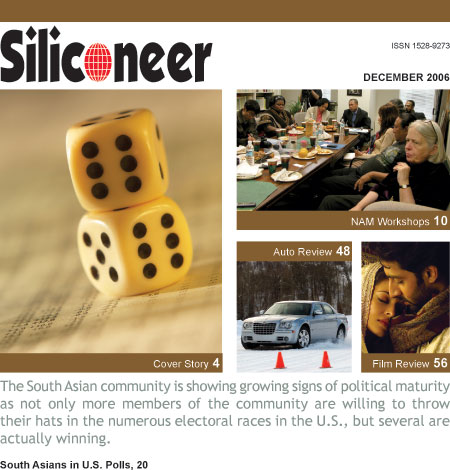 The recent spike of the Bombay Stock Exchange Sensex has made business analysts sit up. Any sharp rise in a stock exchange carries with it the peril of a bursting bubble in the future, but analysts say this bull market is based to a large degree on sold fundamentals, led by the excellent performance of the Indian banking and information and technology sector. The recent spike of the Bombay Stock Exchange Sensex has made business analysts sit up. Any sharp rise in a stock exchange carries with it the peril of a bursting bubble in the future, but analysts say this bull market is based to a large degree on sold fundamentals, led by the excellent performance of the Indian banking and information and technology sector.
Foreign institutional investors seem to be eyeing India with greater relish. FII inflow in October 2006 (till 26 October) reached Rs. 64.99 billion compared to Rs. 46.43 billion in August 2006 and Rs. 54.25 billion in September.
Morgan Stanley says India strategy report has noted that as the demand is growing and Indian companies are operating at full capacity, they are now going for expansion.
The Indian economy is growing at around 9 percent and companies are showing better than expected results.
However, there is reason to be cautious. The heady bull-run at the start of the year sent the benchmark index to a peak on May 11, only to be savaged by an emerging markets sell-off that knocked it back 30 percent by mid-June.
At the end of the day, the element of chance and luck cannot be altogether ignored in the ups and downs of the stock market. How much this actually reflects the actual health of the economy is a matter of speculation.
But as our cover story details, the going is awfully good now, and investors are making a killing. Tomorrow could well be another day, but nobody cares about it right now.
What went wrong in Iraq? As the sickening, horrific news of grisly sectarian strife keeps pouring in, analysts and political observers have been scrambling to offer critiques of what could be America’s biggest foreign policy debacle since Vietnam, not to mention the trauma of the Iraqis themselves.
Amid a flurry of books and articles that have taken the Bush administration to task comes Washington Post managing editor Rajiv Chandrasekaran’s perceptive on book based on his own reportage of Iraq.
It is a credit to the quality of his reporting and analysis that even in a flurry of comment and analysis on Iraq his critique has drawn national attention.
Chandrasekaran’s book makes sobering reading. It is a shocking tale of hubris, partisan pettiness and possible malfeasance that have led to a mess in Iraq which has brought untold misery on the Iraqi people.
In a frank interview with New America Media journalist Sandip Roy, Chandrasekaran gave his take on the current mess in Iraq and what led to it.
Chandrasekaran says that there was a very clear screening process in the Pentagon which focused on people in who would be politically loyal rather than people with skills in Arabic, post-conflict reconstruction, experience in the Middle East.
We carry the detailed interview in this month’s issue.
Octogenarian author Mahasweta Devi is not only a literary institution in her native Bengal, but respected widely in India and even abroad. Winner of the Jnanpith, India’s top literary award, and the Magsaysay Award, she is one author who doesn’t just talk the talk, but also walks the walk.
For decades she has been a strident voice of protest against oppression of India’s most marginalized communities, issuing withering, unsparing critiques of her own Bengali community for its disgraceful treatment of Adivasis. She has also worked for them, helping them organize, and given voice to their hopes and aspirations in “Bortika,” the periodical she edits.
Devi went to Frankfurt this year at the inauguration of the world’s largest book fair, where India was the guest country of honor, and delivered a memorable lecture reflecting on India as well as her life and times, which we carry in this month’s issue.
It was a passionate, angry, loving, poignant conflicting rumination about being Indian.
“From the Indus Valley to the bluetooth handset, India has seen it all, contains it all within itself and its cultures,” she says. “There is room in India for all faiths, all languages, all people. Despite the communal crises, despite the fundamentalism, the backwardness of rural life, the memories of underdevelopment which are no memory but reality for us, the threat of AIDS, tsunamis, earthquakes, floods and droughts, farmer suicides, police violence, environmental disasters wreaked by industries and farmland being bought over by multinational companies, despite the battering by history and circumstance, India still is. Its culture still is. Hence we all, still are. India has learnt to survive, to adapt, to keep the old with the modern, to walk hand in hand with the new millennium whistling a tune from the dawn of time. This is truly the age when the joota is Japani, the patloon Englistani, the lal topi, Roosi. But the dil — the dil is and always will remain Hindustani.”
Do drop us a line with ideas and comments about how we can make Siliconeer better serve you.
|TOP|
COVER STORY:
The Three Trillion Rupee Ride: Sensex Unbound
Driven by the banking and information technology sectors, the Bombay Stock Exchange 30-stock sensitive index has hit the giddy heights of 14,000, with investors making a cool Rs. 3 trillion in just six months, and analysts say more growth is on the way, writes Siddharth Srivastava.
 The banking and information technology sectors have catapulted the Bombay Stock Exchange 30-stock sensitive index over the 14,000 mark for the first time in history, making the investor richer by Rs. 3 trillion in just six and a half months. Analysts say there is reason to hope for more as the India growth story is only bound to get better. The banking and information technology sectors have catapulted the Bombay Stock Exchange 30-stock sensitive index over the 14,000 mark for the first time in history, making the investor richer by Rs. 3 trillion in just six and a half months. Analysts say there is reason to hope for more as the India growth story is only bound to get better.
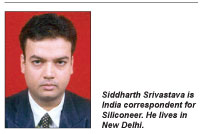 Since Sept. 15, 2006, the Sensex has gone up by around 8.4 percent, the BSE index for banking companies improved by 15.5 percent and that of IT companies also rose by 12.2 percent. The small and mid-cap companies, on the other hand, are yet to reach the previous high. Auto, pharmaceuticals, FMCG, metals as well as the PSUs, also remain depressed. Since Sept. 15, 2006, the Sensex has gone up by around 8.4 percent, the BSE index for banking companies improved by 15.5 percent and that of IT companies also rose by 12.2 percent. The small and mid-cap companies, on the other hand, are yet to reach the previous high. Auto, pharmaceuticals, FMCG, metals as well as the PSUs, also remain depressed.
According to analysts, the skewed bull-run predominantly due to blue chips means that the small and mid cap stocks remain under priced and could make for good pickings for the retail investor. Total investor wealth has now risen to over Rs. 34 trillion from Rs. 31 trillion on April 20 when the Sensex first hit 12,000.
“It is another milestone. The market is backed by strong fundamentals (GDP growth over 8 percent). Corporate performances (over 15 percent) in the last two quarters have been by and large better than expected. Economic factors are also better than ever. The uncertainty over runaway inflation and higher crude prices are not there anymore,” said N Sethuram, chief investment officer at SBI Mutual Fund, in a comment. “If these factors are going to remain the same, the market is likely to go up further.”
The index for large cap companies has moved beyond the peak of pre-May 2006 crash level. Banking stocks, followed by IT, have emerged as the biggest gainers in the wake of robust quarterly results, strong credit growth and capital raising initiatives, adding more than Rs. 450 billion, during the 12,000-13,000 journey, to a total of Rs. 2,700 billion. Metal stocks drove the journey of the Sensex from 11,000-12,000, while up to 11,000 it was the capital goods stocks.
The BSE Bankex index, comprising 18 banking stocks, including giants like SBI, ICICI Bank and HDFC Bank, has risen more than 23 percent since April 20 when the market first hit 12,000.
According to Ravi Sardana of ICICI Bank, rise in the share prices of banking sector companies was a clear indication that the investors have confidence in the Indian economy. “As the general perception in the market is that Indian economy would perform well in the short- to medium-term, there is a demand for the shares of banking sector companies,’’ he said.
In a further fillip to the banking sector, Finance Minister P. Chidambaram has announced a plan to introduce a bill in parliament to lift the 10 percent cap on voting rights for foreign banks acquiring stakes in private Indian banks. He said there was scope for expansion of the banking sector, as it contributes only 50 percent to the gross domestic product.
Earlier Chidambaram has said that the surge in the Indian stock markets was orderly and attributed it to improved corporate prospects and falling oil prices. “That means the movement is orderly,” he said.
In order to check inflation and high credit offtake, the Reserve Bank of India hiked the repo rate by 0.25 percent to 7.25 percent, which should have a further positive impact on the investor sentiments toward the banking stocks.
In other sectors, the combined market cap of 10 IT stocks (which again has reported very good quarter results) present on the index has increased by over Rs. 350 billion to near Rs 3.5 trillion.
India’s top software services companies, TCS, Wipro and Infosys Technologies, have overtaken market expectations by clocking nearly 50 percent growth in revenue (48.24 percent) and net profit (48.52 percent) during the quarter ended September 2006.
Infosys leads the chart with operating margins of 32.14 percent (32 percent), followed by TCS at 28.27 percent (30.25 percent) and Wipro with 21 percent (20.91 percent).
Among the large caps that boosted the index include Reliance Industries (Rs 300 billion surge), Bharti Airtel, Reliance Energy, Reliance Communications (increase Rs 400 billion), Grasim, Infosys, HDFC Bank and ICICI Bank.
ONGC (down Rs 200 billion) and other old economy stocks such as NTPC, ITC, Tata Steel, Tata Motors, Hindalco Industries, Hero Honda and Ranbaxy have, however, lost during this period.
Foreign institutional investors have also increased buying in recent months, despite gloomy sentiments in the Asian, European and U.S. markets. According to the Securities & Exchange Board of India, FII inflow in October 2006 (till 26 October) reached Rs. 64.99 billion compared to Rs. 46.43 billion in August 2006 and Rs. 54.25 billion in September.
Foreign funds have returned to the market after dumping $2.5 billion worth of stocks after the May-June tumble. Their net investment so far this year is over $5.5 billion, still a slower pace than the $10.7 billion seen in 2005. However, since June 14, they’ve bought local shares over $3 billion, surpassing the amount they sold during the rout.
Morgan Stanley in its India strategy report has noted that as the demand is growing and Indian companies are operating at full capacity, they are now going for expansion. The report said capital expenditures by companies, are likely to go up by 50 percent in 2006 and 40 percent in 2007.
Chairman of DSP Merrill Lynch, Hemendra Kothari, has said India continues to be a great growth story. “The Indian economy is growing at around 9 percent and companies are showing better than expected results. Overall, it is a great opportunity for investors,” he said.
However, one has to be cautious still. The overall mood is still less euphoric after the heady bull-run at the start of the year that sent the benchmark index to a peak on May 11, only to be savaged by an emerging markets sell-off that knocked it back 30 percent by mid-June.
“The major difference is that this time there is no euphoria. The market may be at a new high but there are a large number of stocks not at a new high,” said Jayesh Shroff, fund manager at SBI Mutual Fund, to Reuters. “Retail participation is still not near where it was in May.”
Analysts have said that the rally this time is not broad-based and is restricted to a handful of stocks in select sectors. The rise is almost entirely driven by stocks from the services sector, mainly information technology, with manufacturing taking the back seat.
The momentum for the Sensex’s rise has been provided mainly by eight stocks of which three, Infosys, TCS and Satyam, are from the IT sector, two from telecom (Bharti Airtel and Reliance Communications) and two from the finance sector, ICICI and HDFC Bank. Grasim Industries is the sole manufacturing company with a notable increase in value.
|TOP|
ANALYSIS:
Mugged by Reality: The Iraq Mess
Washington Post managing editor Rajiv Chandrasekaran, whose account of the American occupation, “Imperial Life in the Emerald City” was nominated for a 2006 National Book Award, says opportunities in Iraq were squandered long ago when Donald Rumsfeld’s Pentagon won the battle with the State Department over who would call the shots in Baghdad. He talked to New American Media’s Sandip Roy.
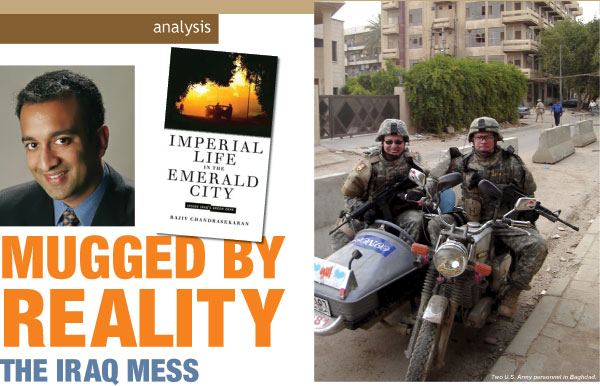
Who coined the term Emerald City?
A number of disaffected people who worked in the Green Zone began to come to the realization that they were living in a fantasy that bore no relation to the real Iraq. So they began to jokingly refer to the Green Zone as the “Emerald City.” It was kind of like going to Disneyland. It was like popping a Prozac.
I read even tomatoes from the fields of Iraq were not allowed into the Green Zone.
They didn’t want to buy food on the local market for fear it might be poisoned. No Iraqis were allowed to work in the kitchen.
Were there loyalty tests before you got a position in the Coalition Provisional Authority?
There was a very clear screening process that took place at the Pentagon. The Office of the White House Liaison to the Pentagon focused on trying to bring people in who would be politically loyal. People with skills in Arabic, post-conflict reconstruction, experience in the Middle East weren’t really valued. People were asked questions like, “What are your views on Roe v. Wade?” “Did you vote for George W. Bush in the 2000 presidential election?”
But political ideology aside, are you saying unqualified people were put in charge of ministries?
There was a view at the highest levels of the Bush administration that bringing in these veteran Middle East experts, would be to bring in people with old ways of thinking, people who were insufficiently committed to democratizing the Middle East. They wanted people with no baggage.
Take “Skip” Berkel, who was the foremost post-conflict healthcare specialist. He has a master’s in public health. He worked in Kosovo and Somalia and Northern Iraq. He’s a naval reservist with two Bronze Stars. The guy had a wall full of degrees, but he didn’t have a picture with the president. So he was replaced by a man who ran a large adoption agency that urged pregnant women not to have abortions.
Would it have been really different if the State Department had won out in the power struggle with the Pentagon?
There would have always been an insurgency driven by zealots. But it didn’t have to be this bad. Here’s a country with 40 percent unemployment. What do Bremer’s economic advisors suggest? A new tax code, and not just a new tax code, but the dream of neoconservatives in this country — a 15 percent flat tax.
But the goal was not just to build democracy, but also to build a free market.
Saddam Hussein had a very ossified, socialist system. It was a very subsidy-laden economy. Fuel was almost free. Fertilizer was so cheap, that Iraqi farmers made more money by smuggling their fertilizer to Syria and selling it than actually using it. The economy was rotten to the core.
But, the question is, how do you go about fixing it? A number of Bremer’s economic advisors felt you privatize things right away. You remove the subsidies. It’s destabilizing in the short term, but it’s what we did in Eastern Europe, and we should do it in Iraq. Their view was that multinational companies like Nestle and Unilever would come in and build big factories. Well, you didn’t have the same security problems that you did in Eastern Europe. The airport wasn’t open. The drive from Jordan was a treacherous 12-hour trek through the desert, Eastern Europe wasn’t under foreign occupation.
By the way, there are international treaties of warfare that prevent an occupying power from selling off the real assets of an occupied country - a set of international laws that was conveniently forgotten in the Green Zone.
Did anything go right?
In the world of higher education we promulgated a bill of rights that would provide academic freedom to professors. We did so little to rebuild Iraqi universities that were looted that most of the repairs were paid for by Shiite political parties. As a quid pro quo their activists hold sway on college campuses. So there may be a bill of rights but effectively the local Imam is in charge of what can or cannot be said.
Do you think democracy was too much too soon?
You can’t just pop the lid off the pressure cooker in one fell swoop. We Americans, have come to think that democracy is easy. It’s not. It requires institutions, a bureaucracy, a free press. John Agresto, a lifelong friend of the Cheneys and Rumsfelds, told me how he got very little money to rebuild looted universities and said: “I feel like a neoconservative who has been mugged by reality.”
Does Paul Bremer share that view?
I certainly think Bremer was mugged by reality. I am not sure he realizes he has lost his wallet.
|TOP|
NEWS DIARY: November Roundup
 Bangla Protest | Marriage Maoist Style in a Nepal Village | Seven Wonders | Pollution Reducing Rice Harvest | Pakistan Elections | The London Allure | Dignity March | Widows Sell Booze Bangla Protest | Marriage Maoist Style in a Nepal Village | Seven Wonders | Pollution Reducing Rice Harvest | Pakistan Elections | The London Allure | Dignity March | Widows Sell Booze
Bangla Protest
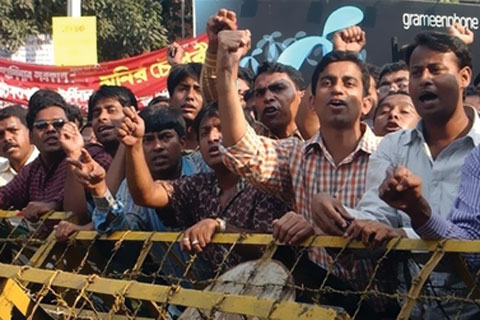 Students activists of the Awami League shout before a police barricade near the Election Commissioner Secretariat in Dhaka. Students activists of the Awami League shout before a police barricade near the Election Commissioner Secretariat in Dhaka.
Bangladesh’s main opposition has threatened to stage fresh protests with up to two million supporters unless its demands for electoral reforms ahead of January elections were met.
“Unless our demands are met within a few days we will hold an indefinite siege of the election commission office and the presidential palace and bring two million people from across the country to enforce the blockade,” said Awami League official Ashim Kumar Ukil.
“We will completely isolate the offices from the rest of the city and continue until our demands are met,” he added.
Some 15,000 opposition supporters gathered close to the election commission office to stage a short demonstration, police said.
There were no reports of any violence.
The main opposition Awami League and its 13 leftist allies suspended the latest indefinite national transport blockade.
The opposition lifted the crippling protest after the interim government, in place to hold free and fair elections, requested the country’s controversial election commission make a number of reforms in line with opposition demands.
The election commission, accused by the opposition of being biased in favor of the outgoing government led by the Bangladesh Nationalist Party, said it had agreed to review the voter list.
The opposition says the list is flawed and contains 14 million ghost voters.
|Back to NEWS Diary| |TOP|
Marriage Maoist Style in a Nepal Village
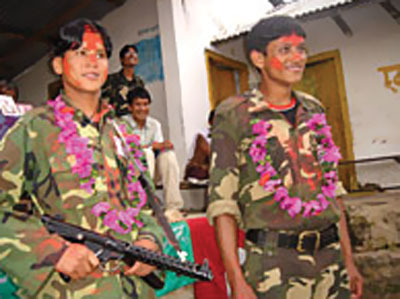
Guns, uniforms part of wedding festivities.
The ceasefire between Nepal’s government and the Maoist rebels appears to be encouraging fighters to get married — in dedicated Maoist style, according to a report by Charles Haviland of BBC News in the land-locked Himalayan country.
One evening in the hills, as the sweet smell of herbs fills the air and the shadows lengthen, in a small village built on a hill, military men and women, mostly young, troop into a school.
Some wear camouflage fatigues, others garish T-shirts. Some carry rifles, others are empty-handed.
This is a wedding party with a difference. Once they get to the school, the first thing on the menu for these 60 or so Maoist soldiers is their usual military drill.
Village children stare from the rooftop as the troops get a lecture on marriage from their commander and hold a minute’s silence for those they recall their martyrs, all arms clenched in what the Maoists call their Red Salute.
The wedding venue is the school veranda, decked with pictures of the iconic figures of communism. On a rough wooden table sit garlands of mauve flowers and four candles.
Two grooms and two brides are sitting among the assembled company. They look deadly serious, and seem reluctant to get up as they are called to the podium amid rhythmic clapping and solemn drumming.
The two grooms are to make speeches. The first, Comrade Samjok, now with a shy smile on his face, a red and black T-shirt visible under his uniform, urges workers of the world to unite and wishes long life to the People’s Army. Then he comes to the point.
“Comrade Anima and I have fallen in love and request a wedding,” he says.
It is then the turn of the other groom, Comrade Sayjan, but his speech is read by a senior Maoist while he and his fiancée stand giving the Red Salute. Then at last the couples allow themselves the luxury of a big grin. Each in turn lights a candle. Bride and groom exchange garlands and apply red blessing powder to the forehead.
|Back to NEWS Diary| |TOP|
Seven Wonders
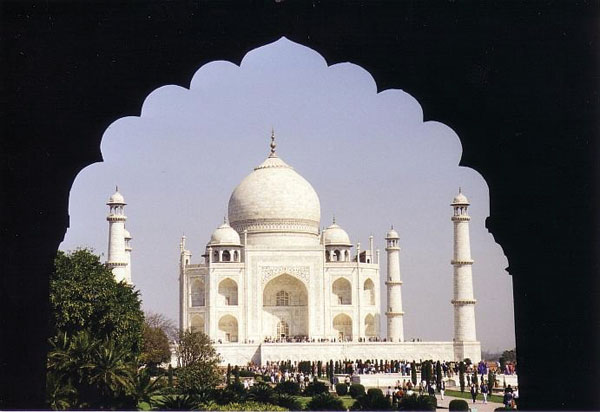
The Taj Mahal at Agra
India’s world famous monument to love, the Taj Mahal, officially entered the race to be one of the new seven wonders of the world, Indian officials said.
The “certificate of candidature” of the 17th-century white marble mausoleum was handed over by Bernard Weber, the founder of the New7Wonders Foundation, to D.K. Burman, a senior tourism official.
The Taj was chosen as one of the 21 finalists out of 77 nominees by online and SMS polls in which millions of people across the globe took part, a statement posted on the New7Wonders Foundation Web site said.
The Indian monument is on a list that includes the Acropolis in Athens, Cambodia’s Angkor Wat temple, the Eiffel Tower in Paris, the Statue of Liberty and the Sydney Opera House, among others.
“The voting (to select the final seven) is to continue till 6th of July 2007 with final declaration to be made in grand gala function on the next day,” the Swiss-born Weber told reporters here.
“It is an golden opportunity for Indians in the final phase to vote for their choice” he said.
The new seven wonders of the world will be announced in the Portuguese capital Lisbon, on July 7, 2007 or 07.07.07.
The magnificent Taj Mahal was built by Emperor Shah Jahan as a tomb for his beloved queen, Mumtaz Mahal, who died while giving birth to their 14th child.
Some 20,000 workers toiled for more than 20 years to build the tomb in an age of opulence when Muslim rulers mined precious gems to fund construction of grand projects.
|Back to NEWS Diary| |TOP|
Pollution Reducing Rice Harvest
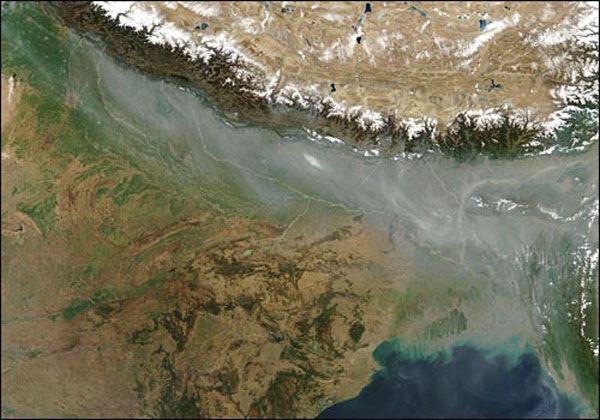
A satellite image reveals brown clouds over India.
Pollution-laden clouds may be partly to blame for India’s dwindling rice harvests, according to research, reports the BBC News Web site.
A U.S. team found that brown clouds, which cloak much of South Asia, have a negative impact on rice output by reducing sunlight and rainfall.
They discovered elevated levels of greenhouse gases also reduced yields.
The study, reported in the Proceedings of the National Academy of Sciences, came a day after researchers said new crops adapted to a warmer climate are needed.
Since the 1980s, India has faced ever-declining growth rates in harvests of its staple food, raising concerns that shortages could occur.
To investigate the cause, researchers looked at the impact of the “brown clouds” or “Asian haze” which cover the region.
South Asia has one of the most widespread atmospheric brown clouds on the planet.
These layers of air pollution, which contain soot and other fine particles, are primarily created from burning fossil fuels and other organic matter.
The clouds interfere with the local climate by blocking the sun’s radiation from reaching the ground, leading to cooler and dimmer conditions. Recent research has revealed the polluted haze can also reduce rainfall.
The team concluded the clouds had a negative effect on rice yields.
A team scientist said while the cooler night-time temperatures caused by the clouds were beneficial for the rice, the negative impact of the decreasing rainfall outweighed these benefits.
Yields would also have been higher under lower concentrations of greenhouse gases, the researchers found.
Many researchers had been worried that reducing brown clouds could boost temperatures and so further diminish rice yields.
The government-run Indian Council of Agricultural Research, however, said it was not immediately concerned with the findings. An ICAR official said that global warming and air pollution could not be limited to a specific country and would have a global impact.
|Back to NEWS Diary| |TOP|
Pakistan Elections
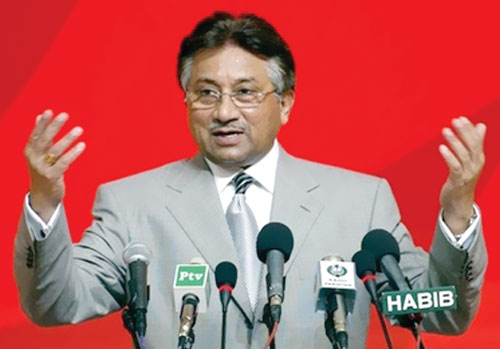 Pervez Musharraf Pervez Musharraf
It may sound like a wedding without the bride and groom, but that’s the way it’s going to be, says Pakistani strongman Pervez Musharraf.
Ending weeks of speculation on the issue, Pakistan President Pervez Musharraf has declared that former prime ministers Benazir Bhutto and Nawaz Sharif would not be permitted to contest the general elections in the country scheduled for November 2007.
In an interview to NDTV’s Prannoy Roy, Musharraf also stated he would continue to wear his army chief’s uniform till the elections but left hanging what would happen after that.
Significantly, he hoped religions “obscurantists” who now rule one of Pakistan’s four provinces and had an overall representation of 17-18 percent in the assemblies would be “defeated” at the general elections.
The Pakistani media has been rife with reports that Bhutto and Sharif were set to return to Pakistan to sink their differences and forge a grand alliance ahead of the general elections.
Both are currently in exile, Bhutto dividing her time between London and Dubai, while Sharif lives in Saudi Arabia.
There were even reports that they would dramatically fly into the country to send a powerful message to their supporters to unite to defeat the ruling Pakistan Muslim League (Quaid) that has Musharraf’s tacit backing and was referred to as the ‘King’s party’ during the 2002 general elections.
Musharraf has now firmly put paid to these grand plans.
“If they come to Pakistan, Nawaz will be sent on next flight back out and Benazir will have to stand trial,” Musharraf said during the interview.
EXTRA TEXT/ USE IF NEEDED
Bhutto faces corruption charges while Sharif left the country under a deal brokered with Musharraf a year after the army chief overthrew him in a bloodless coup in October 1999.
As for his uniform, Musharraf admitted he would “have to take” a “very key decision.”
|Back to NEWS Diary| |TOP|
The London Allure

India is the second biggest foreign investor in London, and will contribute over £33m to the capital’s economy in 2006/7, according to a new estimate.
Inward investment agency Think London said India accounted for 18 percent of foreign investment this year, behind the U.S.
It has helped 36 Indian firms set up in the capital since mid 2005, creating 840 jobs.
London was voted the top European city to locate a business this year, for the seventeenth time in a row.
“London attracts over half of all Indian investment into Europe and provides Indian businesses with a gateway to the continent,” said Think London chief executive Michael Charlton.
London Mayor Ken Livingstone recently launched a “Year of India” campaign to attract more Indian companies to London.
Recent demographic figures show that people of Indian origin constitute the largest single minority group in multicultural London.
Some of the biggest recent bids and acquisitions by Indian companies are:
- The Tata Group trying to pull off the biggest-ever Indian takeover of a foreign company, offering 4.3 billion pounds for Corus, formerly known as British Steel. If it goes ahead, the deal will create the world’s fifth-biggest steel company.
- Tetley Tea, the company that invented the teabag and remains the world’s second-largest producer of teabags, was bought by the Tata Group for 270 million pounds in 2000.
- Apeejay International followed Tata into the market for British tea businesses last October when it bought Typhoo for 80 million pounds from Premier Foods.
- Tyco Global Network, one of the world’s most advanced submarine cable systems, was bought by Tata for 69 million pounds in November 2004.
- Tata also bought Incat International, a British software company, for 53 million pounds last year.
- Indian liquor tycoon Vijay Mallya’s United Breweries is seeking to buy whisky major Whyte & Mackay, which it values at around 400 million pounds.
|Back to NEWS Diary| |TOP|
Dignity March
A large number of men, women and children from across the country participated in a Dalit Dignity March in New Delhi, seeking social and political reforms for their emancipation.
Issues such as the Dalit killings in Khairlanji and the desecration of a statue of B.R. Ambedkar in Kanpur were raised during the rally, held to observe the World Dignity Day.
The participants raised slogans against the Maharashtra and Uttar Pradesh governments for their “failure” to book the culprits in these incidents. Political leaders, cutting across party lines, extended their support to the Dalits.
Addressing the rally, Communist Party of India national secretary D. Raja said: “Dalits and adivasis are the most oppressed sections of society. Khairlanji is not an isolated incident. Atrocities against Dalits are on the rise and have become more brutal than before.”
Former Madhya Pradesh Chief Minister Digvijay Singh expressed his solidarity with the Dalits. “Governments need to clear the backlog of vacancies in the category of reserved jobs. They must also take affirmative action to give Dalits economic independence.”
|Back to NEWS Diary| |TOP|
Widows Sell Booze
The death of their spouses due to alcoholism has failed to deter hundreds of widows — in villages near Surat in Gujarat — who have taken up bootlegging as a means to make a living for the family.
There are some villages with a large number of widows who brew country liquor and sell it either from their homes or supply it to other bootleggers. Sukhi Rathod, who lost her alcoholic husband about three years ago, was one of the many arrested by Task Force officials from Dabholi village for bootlegging.
She admitted that it was her third arrest, but said she would continue bootlegging, which gets her Rs. 100 per day.
According to data from TF officials, in the current year, 42 women bootleggers were arrested from Udhna, Limbayat,Varachha and Kapodra police stations, 78 from Salabatpura, Mahidharpura, Katargam and Chowk and 41 from Rander and Ichhapore.
For the likes of Sukhi, death of males due to alcohol addiction is nothing shocking, as in the villages where country liquor is brewed, male children take the first sip of liquor at the age of 10.
|Back to NEWS Diary| |TOP|
|